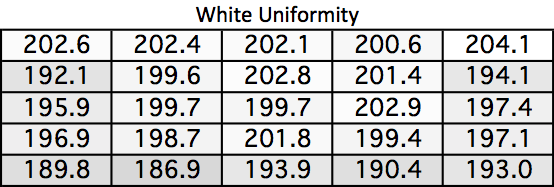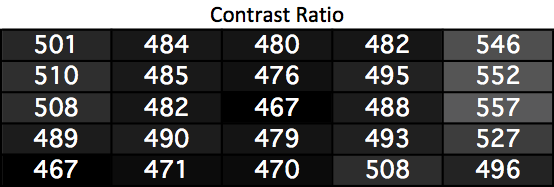Samsung S27B971D Monitor Review
by Chris Heinonen on October 31, 2013 12:00 PM ESTThe only way to describe the uniformity data is “also amazing.” Rivaling or even exceeding what I have seen from NECs professional displays, the uniformity of the S27B971D is superb. White uniformity is all within 8% of each other, which is likely to not be noticed in real life. Even the dimmest area on the screen only drops by 6% which I did not notice when using it. Like NEC the high-brightness setting probably affects uniformity as well, but using the sRGB mode it stays incredibly uniform.


Black levels have more of a fall-off but not for the usual reason. Typically black uniformity is bad because of some bright corners or edges, but here it is less uniform because the edges are darker. I’m not going to complain about this as it is much better than having bright corners around the screen. I’m assuming the higher overall black levels are due to the technology they are using to produce the uniformity in the display. As I mentioned with the calibration bench, if you need contrast ratios, you can use the movie mode for that. For work where color accuracy and uniformity are more important the sRGB mode is perfect.


With our white levels being totally stable the contrast uniformity varies due to the black levels. The good news is that it varies in a good way, with the edges of the screen being more dynamic than the center. It never exceeds 557:1 so it still lacks the pop of a VA panel, but it is very stable across the screen.


Saving the best for last, color uniformity is perfect. Only two values exceed 1.0 dE2000 on average when compared to the center, and the largest average is 1.23. When you look at an image on the screen, colors will match the rest of the screen and everything will look correct. Phenomenal results here from Samsung.

Despite Samsung billing this as a professional display, I didn’t expect these kinds of results. Even when I saw their 25-point calibration demo or the document that came with the display I didn’t expect it. However Samsung has made a display that ranks up with displays costing hundreds of dollars more in terms of uniformity and accuracy.










52 Comments
View All Comments
hbsource - Thursday, October 31, 2013 - link
As someone once said, 'There's no such thing as a bad product, just bad pricing.' That seems to be the case here.Da W - Thursday, October 31, 2013 - link
For that price i got 3 ASUS PA248Q monitors, which are pretty good.hero1 - Thursday, October 31, 2013 - link
Tell me about it. That is way more than the Dell U2713HM that I have. Samsung screwed up here.Silma - Saturday, November 2, 2013 - link
Very happy with the Dell U2713HM, far less expensive and superior in almost all ways to the Samsung.Gothmoth - Saturday, November 2, 2013 - link
the dell 2713HM is complete crap fro real work.it´s a gaming monitor but no match for people who need a good colormanaged monitor.
no sane person intersted in accuracy would use the dell over a eizo or nec.
the samsung is better then the dell but no match to eizo or nec monitors aroun 1000 euro.
wavetrex - Sunday, November 3, 2013 - link
Who said every monitor must be for GRAPHICS work ?I can work my programming just fine on the 2713HM and do everything else on the computer without noticing any real "color" problems. Excellent monitor for the price !
This Samsung however breaks the bank. 27" WQHD really need to come down in price, not up...
cheinonen - Friday, November 1, 2013 - link
The PA248Q is only 1920x1200 so Apples to Oranges, but yes the price is wrong. If the measured performance had matched the data sheet, it would have worked at $1,000 for a certain audience. That after a WQHD display with really accurate color and uniformity but that doesn't need a color gamut beyond sRGB. As the post-calibration numbers show, it is capable of very high performance.Unfortunately it didn't meet that. I don't know if mine was a bad sample or if they measure a different way, but it didn't hit the level of performance the price point would require. It's a nice display, I've been using it post-calibration and it's really great, but most people lack $1,000+ in calibration gear to bring out that performance. Hopefully Samsung can get it right in the next generation, because it has a lot of potential.
deeps6x - Friday, November 1, 2013 - link
"The PA248Q is only 1920x1200.."Quite frankly I'd rather have the extra 120 pixels in screen height than the higher resolution.
2560 x 1600 monitors please.
Bakes - Friday, November 1, 2013 - link
I have to agree with you. I think 16:10 just seems more usable. I don't mind that movies are letterboxed.Death666Angel - Friday, November 1, 2013 - link
Have you used a 27" 1440p monitor? Sure, 1600p is great, but they usually cost twice as much and there is much less competition. I came from a 24" 1920x1200 monitor to a Samsung S27A850D (luckily without the complaints many people had with it, lots of backlight bleed and other stuff), and the narrower picture doesn't really bother me, the higher resolution in all axes is much more important for me. And since Win7 with the easy side-by-side view of applications, productivity is even higher.